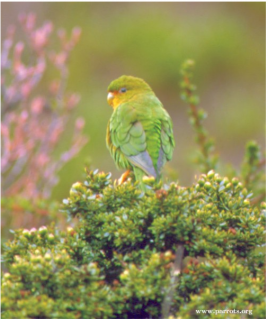Project Regions:
Rufous-fronted Parakeet |
|
|
Collaborators/Funders
American Bird Conservancy (ABC), ProAves Colombia
Rufous-fronted Parakeet populations in jeopardy
The Rufous-fronted Parakeet (Bolborhynchus ferrugineifrons) is losing habitat to agriculture, grazing and conversion to firewood.
Project and progress: In 2001 WPT granted American Bird Conservancy funds to help the NGO Proyecto Ognorhynchus preserve and study the parrots of the Andes, which included Yellow-eared Conures and the Rufous-fronted Parakeet.
Outcomes: A report by researcher Niels Krabb found that, of the thirty-two species of parrot restricted to the Andes and the temperate zone of Patagonia, fifteen, including the Rufous-fronted Parakeet, are considered threatened with extinction, primarily because of habitat loss through deforestation. Poaching was another main concern. The study determined that knowledge of species' distribution and population status was required for planning and beginning conservation measures. It also decided that for the parrots of the Andean region conservation through in-country programmes would result in the best outcome.
Wild population: 2000 - 4000
Where found: Found in Cordillera Central, C Colombia.
History: The Rufous-fronted Parakeet, or Bolborhynchus ferrugineifrons, is found only in the C Andes of Colombia, mainly in the Volcan Ruiz-Tolima massif in Tolima, Risaralda, Quindio and Caldas. There it exists on cold, scrubby and sparsely wooded mountain slopes, known as paramo, feeding on grass seeds, herbs and flowers. Loss of the specific paramo vegetation seems to have had the most adverse effect on population numbers. Although trapping for the bird trade exists, it is not thought to have been significant enough to cause a decline in the population.
Threats:
- Habitat destruction and degradation of paramo vegetation
- Exploitation of the forest for firewood and overgrazing by livestock at higher elevations
- Conversion of forest for agriculture at below 3000m
Ecology: The Rufous-fronted Parakeet is found in cold and sparsely wooded hillsides at an altitude of 2400-4000m (7872-13,120 ft). Birds feed on grass seeds on the ground, herbs and flowers. May be found in potato fields. They may be nomadic outside of breeding season; birds are gregarious and easily approached.


































